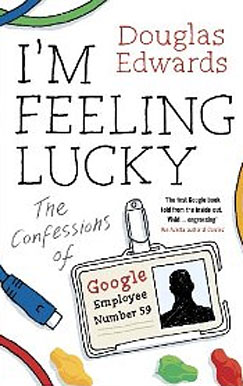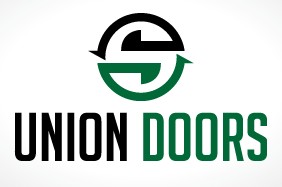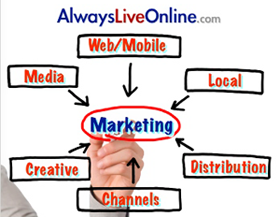The Confessions of Google Employee Number 59
Article Courtesy of: Greg Jarboe
Don’t wait until Christmas. Don’t wait for your birthday.
Buy I’m Feeling Lucky: The Confessions of Google Employee Number 59 by Douglas Edwards today and read it in the next two weeks before you go to SES San Francisco 2011.
Why? Because letting one of Google’s early employees take you on a trip inside the hyper-energized company that broke the rules and rocked the world will put everything that you will learn at this year’s leading search and social marketing event into context. I can’t tell you how many “ah ha” moments I’ve had while reading the 432-page book over the last couple of weeks.
For example, in the “CableFest ’99” section of Part 1 of the book, I learned that Google’s “beating heart” is made of computer hardware. Yep, the machines in the company’s data centers.
Now, if you’ve ever been inside a server farm, then you’ve seen what Edwards describes as “an enormous, extremely well kept zoo, with chain-link walls draped from floor to ceiling creating rows of large fenced cages vanishing somewhere in the far, dark reaches of the Matrix.”
But, that’s not what Google’s cage looked like.
According to Edwards, “it felt like a shotgun shack blighting a neighborhood of gated mansions. Every square inch was crammed with racks bristling with stripped-down CPUs. There were twenty-one racks and more than fifteen hundred machines, each sprouting cables like Play-Doh pushed through a spaghetti press.”
He observes, “In late 1999, Google began accelerating its climb to market domination. The media started whispering about the first search engine that actually worked, and users began telling their friends to give Google a try. More users meant more queries, and that meant more machines to respond to them.”
Edwards adds, “Unfortunately, computers had suddenly become very hard to get. At the height of the dot-com madness, suppliers were so busy with big customers that they couldn’t be bothered fending off the hell-hounds of demand snapping at Google’s heels. A global shortage of RAM (memory) made it worse, and Google’s system, which had never been all that robust, started wheezing asthmatically.”
Now, I understand why Google hates duplicate content, even non-malicious duplicate content like printer-only versions of web pages. Multiple pages with largely identical content require Google to add more machines without giving users a better experience.
In the “Here Comes You-Know-Who” section of Part II of the book I learned what Google did in the summer of 2000 at the same time it was landing “a big hairy deal” with Yahoo!
According to Edwards, “Larry (Page) and Sergey (Brin) committed to Yahoo! that Google would make numerous improvements in a matter of weeks: to set up two new data centers – including one on the East Coast – to freshen the index by crawling more frequently, to reduce spam in results, and to meet strict limits on latency, the time between the search being entered and the results being delivered. Each of these promises would require enormous effort to fulfill, but if all were met, Google would give Yahoo users a visibly better search experience.”
That’s the same time that Google decided to become the first search engine with an index of a billion URLs.
Edwards notes, “A billion URLs were not required for the Yahoo deal, but to the crawl team, the ‘1B’ index held epic significance. It would catapult Google into the undisputed lead as the builder of the best, most scalable search technology in the world.”
He observes, “Given the two equally impossible tasks – meeting Yahoo’s requirements and creating the world’s first billion-URL index – Larry and Sergey doubled down. Google would do both and do them at the same time. Google would begin answering Yahoo queries on Monday, July 3, leaving the Fourth of July holiday to repair any major disasters that might occur. It was a one-day margin of error in which to parse convoluted code, find bugs, squash them, and, if necessary, restart a system that had never dealt with the load it would now be called upon to carry twenty-four hours a day, seven days a week.”
Now, I understand why Google isn’t afraid to take on Microsoft in search, Facebook in social media, and Apple in smartphones all at the same time. Been there, done that, got the t-shirt.
In “The Sell of a New Machine” section of Part III of the book I learned how Salar Kamangar led the charge to turn Google AdWords into a new system based on cost per click (CPC) instead of cost per thousand impressions (CPM).
According to Edwards, “Salar did his best thinking late at night. He walked the bike-lined halls of the Googleplex after dark, thinking about how ads were sold, how they were displayed, and how they could be improved. In the cubicles around him, Matt Cutts and a handful of other engineers worked on maintaining the AdWords system.”
He adds, “Salar believed that to truly grow Google’s revenue we needed to distribute ads on other websites. Advertisers would be unwilling to pay CPM rates to have their ads displayed across a network of sites over which they had little control. They would be much more comfortable if they paid only when people actually clicked on their ads. But if we were going to do CPC, we had to do it differently than GoTo. We had to do it better. The question was how.”
Edwards concludes, “Salar immersed himself in discussions and brainstorming with the engineering team. They shot down most of his ideas, such as selling keywords in bundles, until one night Salar experienced an epiphany. Google could assign a quality score to each ad. ‘Quality’ would be our prediction of how likely a user was to click on an ad. If that score was factored with the amount the advertiser was willing to pay, we could rank ads by their potential for earning money for Google – their effective CPM. Everybody would benefit. The user would see more relevant ads. The advertiser would get more clicks. Google would make more revenue. It was a brilliant idea.”
How brilliant? Well, let’s fast forward to the latest results.
On July 14, 2011, Google announced financial results for the quarter ended June 30, 2011. In a press release, Larry Page, CEO of Google, said, “We had a great quarter, with revenue up 32% year on year for a record breaking over $9 billion of revenue.”
So run, don’t walk, to your nearest bookstore. If all the bookstores in your community have been liquidated, then go to Amazon.com and order I’m Feeling Lucky now. However you get your hands on this book, read it before you go to SES San Francisco, which will be held Aug. 15-19, 2011.
Edwards captures the “Google Experience,” the roller-coaster ride of being part of a company creating itself in a whole new universe. And you’ll want to know how the ride began in order to understand where it is currently taking all of us in search and social marketing.





















You must be logged in to post a comment.